Flat Feet
Do you have flat feet? You’re not alone. Flat feet are a condition that affects millions of people. If you have flat feet, don’t worry, there are treatments available to help you. This blog post will discuss the causes and treatments of flat feet. So, if you’re wondering what to do about your flat feet, keep reading!
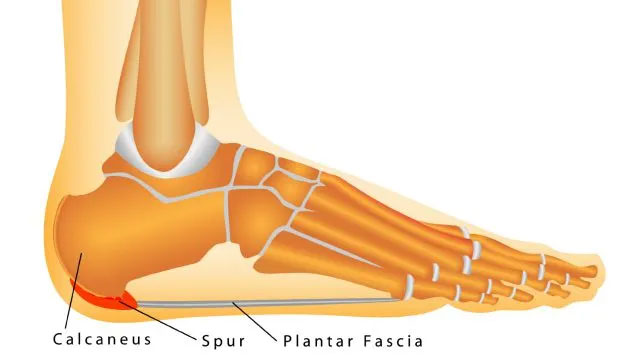
Flat Feet: An introduction
Flat feet, also called fallen arches flat feet or pes planus, is a condition in which the arch of the foot collapses and comes into contact with the ground. This can happen when the tissues that normally support the arch weaken or break down. Flat feet can cause pain in the ankles, knees, hips, and lower back.
People with flat feet may also find it difficult to walk or run. Some people are born with flat feet, while others develop the condition over time.
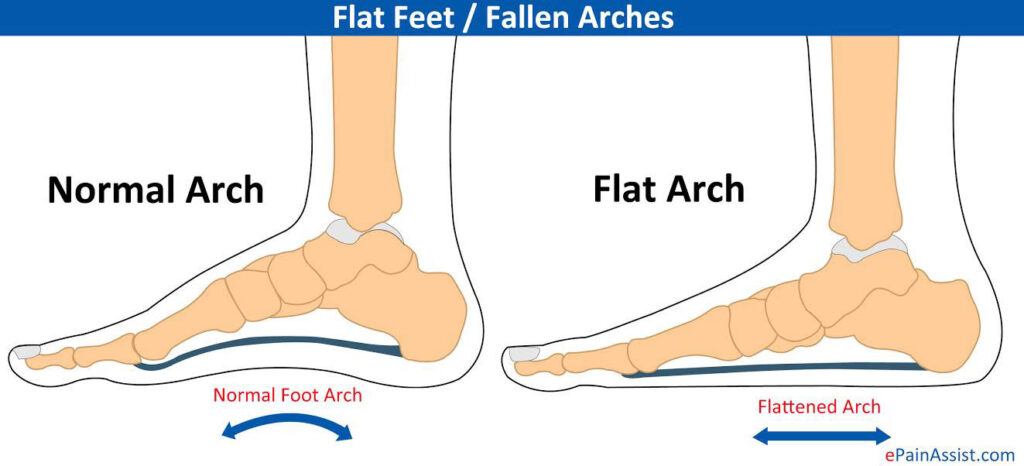
Types of Flat Feet
There are three types of flat feet, each with different causes and treatment options.
Flexible Flatfoot:
The most common type is flexible flatfoot, which is often simply a matter of tight ligaments or tendons in the foot. This can often be treated with stretching exercises or shoe inserts (orthotics).
Rigid FlatFoot:
The second type is rigid flat foot, which is caused by a deformity in the bones of the foot. This can be treated with surgery, but often requires a long recovery period.
Arched Flatfoot:
The third type is high-arched flatfoot, which is less common and is often caused by an injury or illness that damages the tendons in the foot. This type of flat foot arch can be very difficult to treat and may require a combination of surgery and physical therapy.
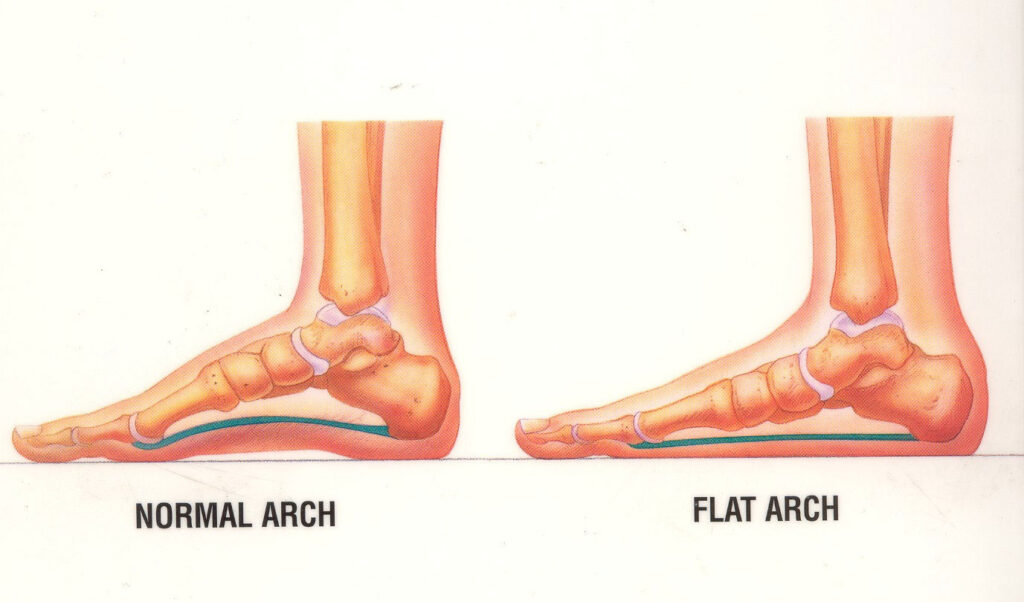
Causes behind Flat Feet:
There are many different anatomical causes of developing flat feet. Here are some of the most common reasons people develop flat feet:
Posterior tibial tendon dysfunction:
This is one of the most common causes of flatfoot. The posterior tibial tendon is a major tendon that attaches to the bones on the inside of your foot and provides support for the arch. If this tendon becomes weak or damaged, it can cause the arch to collapse.
Flat feet in children:
Many children are born with flat feet because their arches have not yet developed. This is normal and usually does not cause any problems. In some cases, however, the child’s arches may never develop or they may develop only partially. This can lead to flatfoot in adulthood.
Arthritis:
Arthritis of the foot and ankle can destroy the joints that support the arch of your foot, leading to flatfoot. This type of arthritis is most commonly seen in older adults.
Injury:
A severe injury to your foot or ankle can damage the bones, ligaments or tendons that support your arch, causing a flatfoot.
Diabetes:
Diabetes can damage the nerves that provide feeling in your feet and lead to problems with balance and coordination. This can increase your risk of falling and sustaining an injury to your foot or ankle, which can then lead to flatfoot.
Obesity:
Being overweight or obese places extra strain on your feet and ankles, which can damage the tissues and lead to flatfoot.
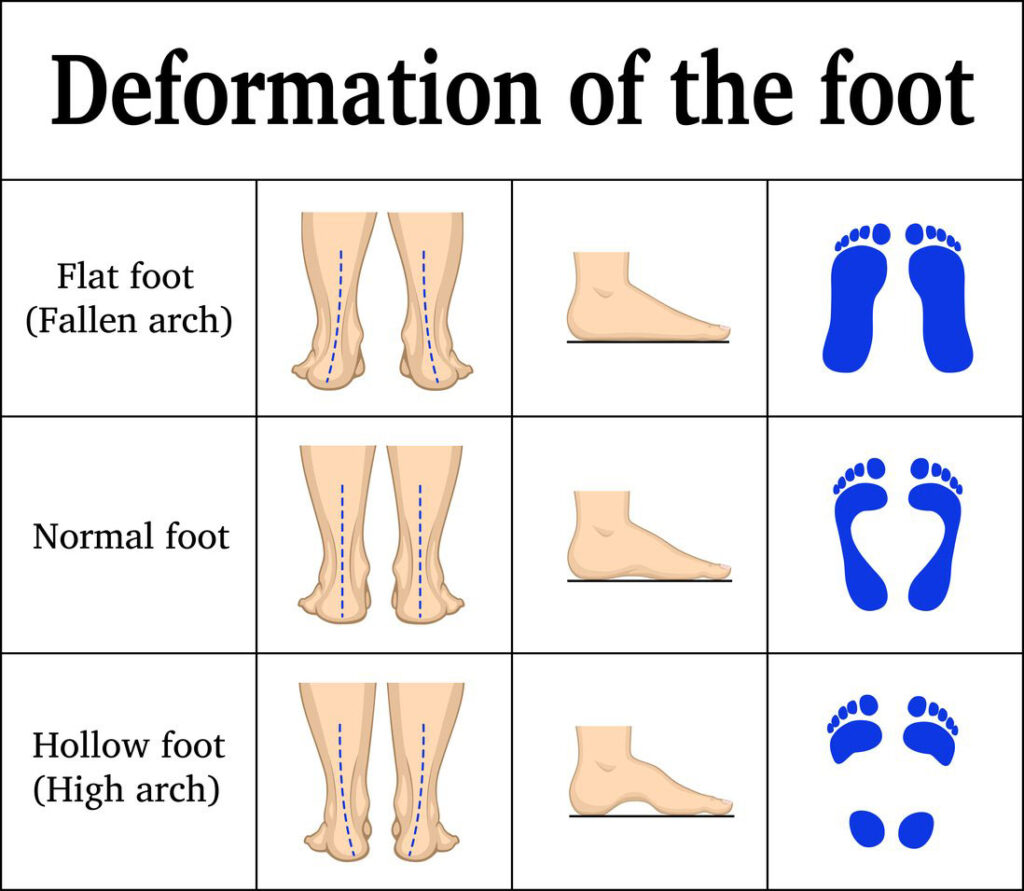
Symptoms of Flat Feet
There are a number of different symptoms that can be associated with flat feet. Some of the more common symptoms include:
-Pain in the feet, ankles, or lower legs
-Swelling in the feet or ankles
-A feeling of fatigue or exhaustion after standing or walking for long periods of time
-Difficulty standing on the toes
-A tendency to pronate, or roll the feet inward when walking
-Calluses or corns on the soles of the feet
-Flat spots on shoes from wear patterns.
If you are experiencing any of these symptoms, it is important to consult with a podiatrist or other medical professional to determine if you have flat feet and to discuss treatment options. Treatment for flat feet may involve the use of special exercises, orthotic devices, or shoe inserts. In some cases, surgery may be necessary.
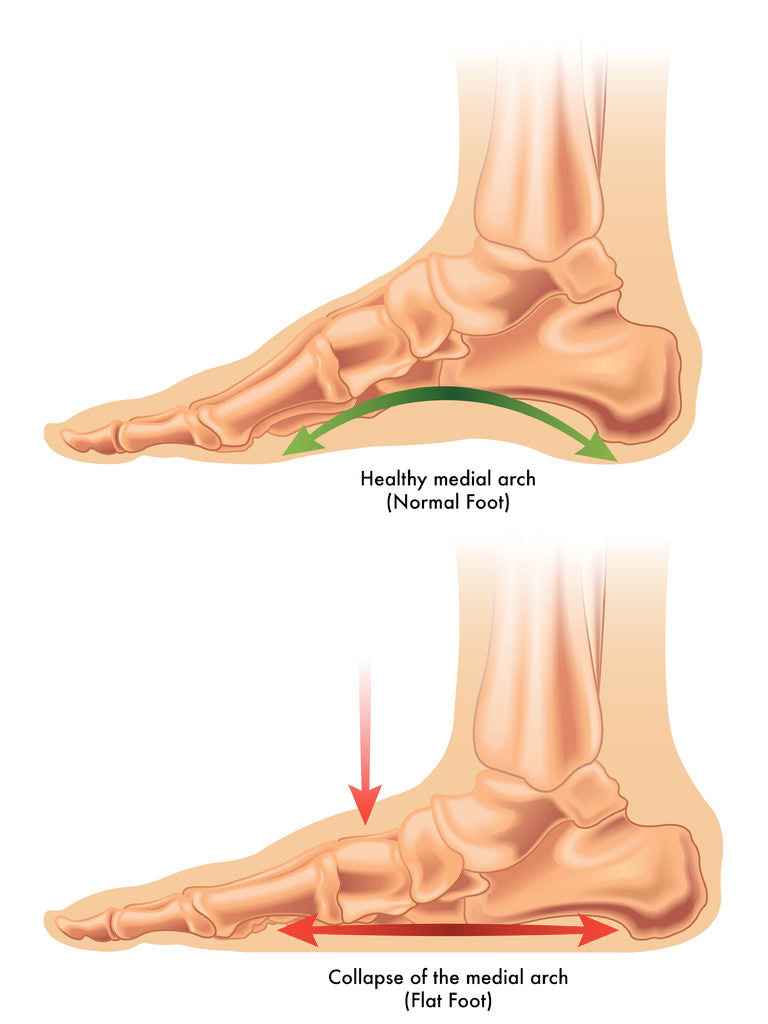
How are flat feet diagnosed?
There are a few ways of diagnosing flat feet. Doctors will take a medical history, do a physical examination, and order X-rays. Sometimes they will also order an MRI or CT scan.
Medical history:
The doctor will ask about any symptoms you have and when they started. He or she will ask if anyone in your family has flat feet. The doctor will want to know about any other medical conditions you have and any medicines you take.
Physical examination:
The doctor will look at your feet and legs. He or she will also ask you to stand, walk, and run. The doctor may also check the range of motion of your ankles, knees, and hips.
X-rays:
These images can show how the bones in your feet are aligned. They can also show if there is any damage to the bones.
MRI or CT scan:
These scans can create detailed images of soft tissues, such as tendons and ligaments. This can help the doctor see what is causing the flat feet.
Treatment for Flat Feet
If you have any symptoms of a sports hernia, such as pain or tenderness in your groin, see your doctor. Early diagnosis and treatment is important to help prevent further damage to the muscles and tendons in your groin.
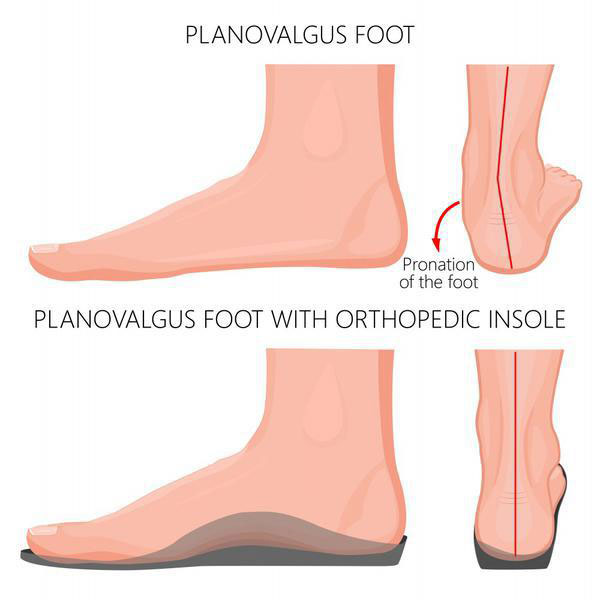
Recovery time for a sports hernia
There is no one-size-fits-all answer to the question of how to treat flat feet. The best course of action depends on the specific condition that is causing your flat feet. For example, if you have a condition called posterior tibial tendon dysfunction (PTTD), you may need surgery to correct it.
If you have flat feet because of ankle injuries or other conditions, such as rheumatoid arthritis, treatment will focus on relieving pain and restoring function. This may include physical therapy, orthotic devices, or steroid injections.
In some cases, simple lifestyle changes can help relieve symptoms of flat feet. These include wearing supportive shoes and avoiding high heels. It may also help to avoid activities that put stress on the feet, such as running or playing tennis.
If you have flat feet and are experiencing pain or other problems, talk to your doctor. They can help you determine the best course of treatment for your individual situation.
Measures to prevent Flat Feet
There are a few things you can do to help prevent flat feet. These include:
-Wearing supportive shoes, such as those with good arch support to make up for the fallen arch
-Avoiding high heels
-Stretching the tight Achilles tendon and calf muscles regularly
-Doing exercises that strengthen the muscles around the ankle and foot
If you have flat feet, talk to your doctor about what you can do to prevent further problems. They may recommend special exercises or orthotic devices. In some cases, surgery may be necessary.
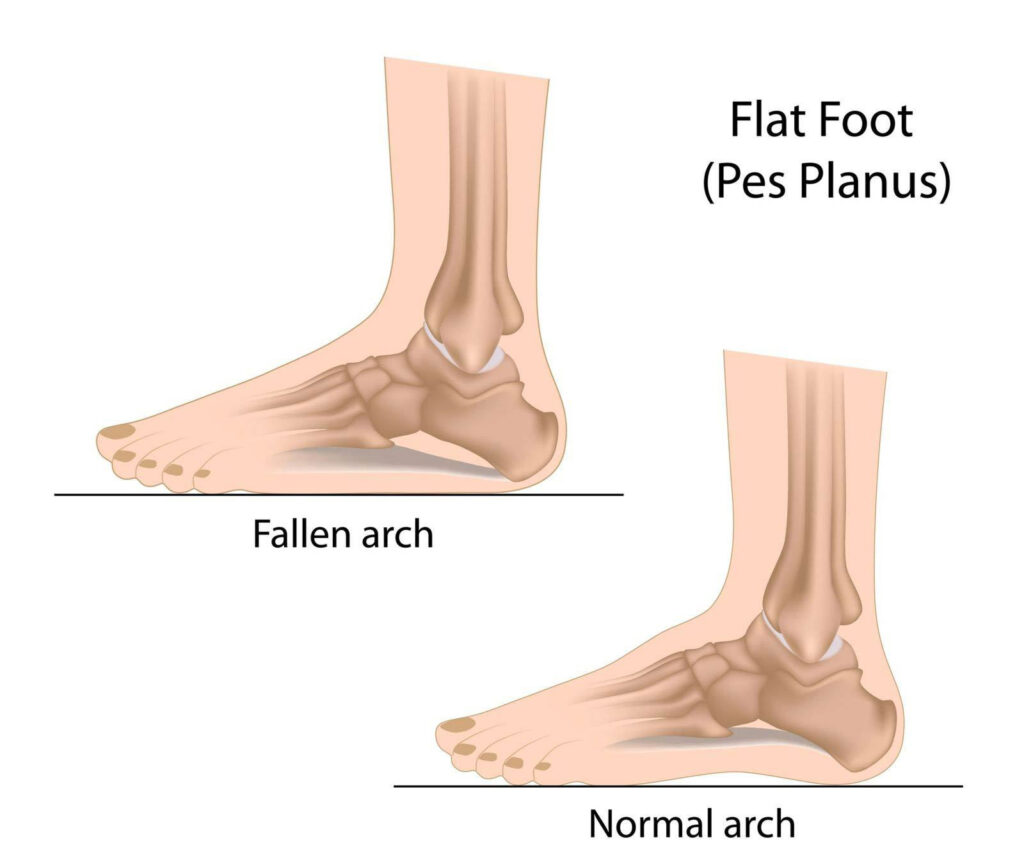
The prognosis for flat-foot people
The outlook for people with flat feet is generally good. Most people with this problem never have pain from their Flat Feet. Children with Flexible Flat Feet usually outgrow the condition by adolescence, when normal arch develops in most people.
There are several different types of Flat Feet, and each has a different prognosis (outlook). The most common type of Flat Foot is the flexible Flat Foot, which generally doesn’t cause any problems.
People with rigid Flat Feet may have pain in their feet and ankles when they stand or walk for long periods of time. They also may have difficulty walking or running because their feet can’t move as they should. People with this type of Flat Foot often need special shoes, arch supports, or other treatments to relieve their pain.
A small number of people with Flat Feet have a condition called tarsal coalition. This condition occurs when two or more bones in the foot fuse together. People with tarsal coalitions often have rigid Flat Feet and may need surgery to correct the problem.
Most people with Flat Feet never experience any problems. However, if you have pain in your feet or ankles, you should see your doctor or podiatrist (foot doctor). He or she can evaluate your condition and recommend the best treatment for you.
Frequently Asked Questions about Flat Feet
You should ask your doctor the following questions:
- What is the cause of my flat feet?
- Are my flat feet a temporary condition or a permanent condition?
- What are the consequences of flat feet?
- What treatment options are available for flat feet?
- Which treatment option is best for me?
- What are the risks and side effects associated with each treatment option?
- How long will it take for my flat feet to improve?
- Will my flat feet ever fully recover?
- What can I do to prevent flat feet from getting worse?
There are a few home remedies that may help relieve the foot pain and discomfort associated with flat feet. These include:
- Resting your feet as much as possible.
- Putting ice on your feet to reduce inflammation.
- Wearing supportive shoes or arch supports.
- Doing foot exercises and stretches to improve flexibility.
- Massaging your feet with lotions or balms.
There is currently a great deal of research being conducted on flat feet. Some of the most promising research is focused on developing new treatments and therapies that can improve the condition. Additionally, researchers are also working to better understand the causes of flat feet in order to develop more effective prevention strategies.
If you would like to learn more about flat feet, there are a few resources that you can consult. Your doctor or a certified foot specialist can provide you with more detailed information about the condition. Additionally, there are a number of books and websites that provide comprehensive information about flat feet. Finally, support groups for people with flat feet can be a great source of information and support.
Have you been injured at some point in your journey?
Are you not achieving your highest level of function?
We’ve helped hundreds of people at all walks in life
get back to performing their best painfree!
3 Ways to Level Up Your Rehab and Injury Prevention With Us





